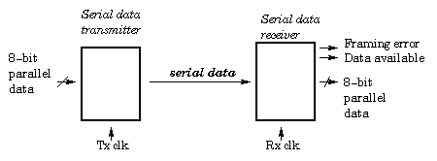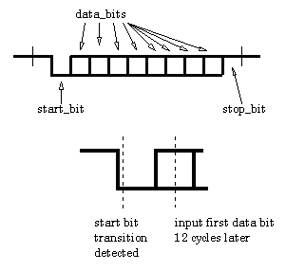Many thanks to Gerard Blair at the University of Edinburgh for allowing us to use his UAR model for February's Model of the Month. If you have a model that you are willing to have advertised on these pages, please drop us a line by clicking here.
OK, on with this month's model...

The above figure shows a simplified picture of an asynchronous serial interface of the type commonly used to transfer data in computer and communications systems. The data transfer is referred to as 'asynchronous' because the spacing between the characters may be of any length. In contrast, the timing of the bits within the character is well defined (and is related to the baud rate of the interface). The Tx clock and Rx clock signals are nominally of the same frequency, but are generated locally at each end of the transmission link and therefore cannot be assumed to be ‘locked' together. The design of a suitable transmitter circuit is not difficult, but the receiver must be able to detect the start of an incoming character and then store the value of each data bit, despite the fact that the relative frequency and phase of the Tx and Rx clocks may vary.

As shown in the data diagram above, the beginning and end of each character is delimited by a start bit whose value is always 0, and a stop bit whose value is always 1. In between characters, the transmitter outputs a constant value of 1. In operation, the receiver continually samples the input data. Following a 1 -> 0 data input transition, the eight data bits must be stored, and this is where a problem may occur, since for maximum reliability we wish to sample the data bits in the centre of their bit times and not close to either edge, so that small differences between the Tx and Rx clocks can be accommodated. This may be accomplished by using an Rx clock frequency which is a multiple of the data bit rate. In this exercise we shall assume that the Rx clock signal is eight times the bit rate.
Following the detection of a start bit, the stop bit should be detected 76 clock cycles later. If so, the Data Available output is set high; if not, the Framing Error output is set. Both status outputs are reset low by the detection of the next start bit.
There is thought to be a danger of spikes on the communication channel falsely starting the receiver. This means that a momentary LOW on the input to the receiver would be seen as a one-to-zero transition whereas it is really just noise.
To counter this, the specification is changed as follows:
- The start bit is a one-to zero transition where the input signal is still zero four (or three or five) samples later.
Thus you will have to update your design for detecting a valid start bit.
Note: The flexibility of 3-4-5 clock periods is to allow pyou to implement whichever is simplest - BUT there is no definition of what value is on the input at the sample AFTER the one-to-zero transition: this is to avoid problems associated with signal bounce.
Well, that's the specification for a UAR model. Here is a design based on sound synchronous design principles.
The following Verilog code has five major sub-modules:
- A start detector which deals with recognizing the beginning of a new data frame. This sends a signal to set the...
- control module into run mode.
- A counter generates a pulse every 8 bits to input the data (thus sampled in the middle of the valid period) serially into a...
- serial-parallel shift register. On the last bit of the data frame, the shift register is not updated, but rather the..
- flags are set according to the value of the stop bit.
As with all good synchronous modules, a global_reset signal is included so that the registers can be put into a known state at the start of testing.
You are welcome to use the source code we provide but you must keep the copyright notice with the code (see the Notices page for details).
// Universal Asynchronous Receiver
//
// +-----------------------------+
// | Library : Datacomms |
// | designer : Gerard Blair |
// | opened: 03 Feb 1997 |
// +-----------------------------+
// Architectures:
// 03.02.97 uar
// Start detection
module start_detect (valid, clk, reset, gl_reset, dIn);
output valid;
input clk, reset, gl_reset, dIn;
reg [3:0] shift_reg;
always @ (posedge clk) begin
if (reset | gl_reset)
shift_reg = 0;
else
shift_reg = { shift_reg[2:0], dIn };
end
assign valid = (shift_reg [0] == 0) &
(shift_reg [2] == 0) &
(shift_reg [3] == 1);
endmodule
// controller
module counter (count72, count8, clk, enable);
output count72, count8;
input clk, enable;
wire each8;
reg [8:0] count_reg;
always @ (posedge clk)
if (enable == 0)
count_reg <= 0;
else begin
count_reg <= count_reg + 1;
end
assign each8 = ((count_reg % 8) == 7);
assign count72 = (count_reg == 71);
assign count8 = each8 & ~count72;
endmodule
// serial parallel converter
module ser_par_conv (dOut, clk, enable, dIn);
output [7:0] dOut;
input clk, enable, dIn;
reg [7:0] dOut;
always @ (posedge clk)
if (enable == 1)
dOut = {dIn, dOut[7:1]};
endmodule
// flags for ready and data error
module flags (dReady, dError, clk, set, reset, dIn);
output dReady, dError;
input clk, set, reset, dIn;
reg dReady, dError;
always @(posedge clk)
if (reset == 1) begin
dReady = 0;
dError = 0;
end
else if (set == 1) begin
dReady <= dIn;
dError <= ~dIn;
end
initial $monitor("dReady %b %b", dReady, dError, $time);
endmodule
// generating the run signals
module control (running, clk, reset, gl_reset, set);
output running;
input clk, reset, gl_reset, set;
reg running;
always @ (posedge clk)
if ((reset == 1) | (gl_reset == 1))
running = 0;
else if (set == 1)
running = 1;
endmodule
// overall receiver definition
module uar (dOut, dReady, dError, clk, gl_reset, dIn);
output [7:0] dOut;
output dReady, dError;
input clk, gl_reset, dIn;
wire running, finish, count8, start;
start_detect s_d (start, clk, running, gl_reset, dIn);
counter cov (finish, count8, clk, running);
ser_par_conv s_p (dOut, clk, count8, dIn);
flags fla (dReady, dError, clk, finish, start, dIn);
control con (running, clk, finish, gl_reset, start);
endmodule
To download the Verilog source code for this month's Model of the Month, click here.
Your e-mail comments are welcome - send email




